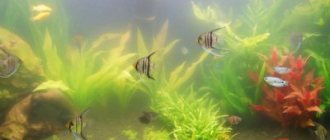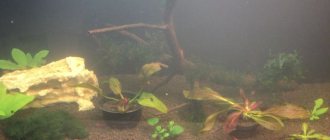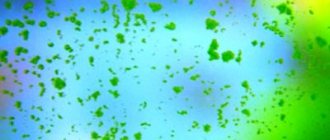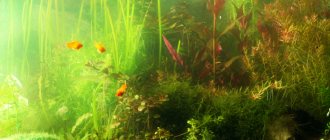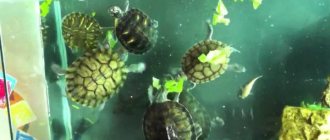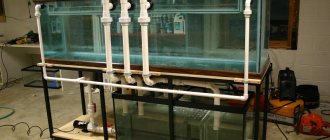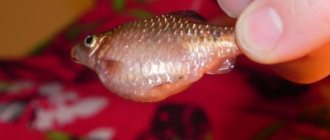Cloudy water in the aquarium, what to do? Many novice aquarists get very scared when they first notice this phenomenon. And for good reason! Not all types of turbidity can be safe: some lead to the death of all the inhabitants of the aquarium in a matter of days. In this article we will study this issue in detail.
Types of dregs
Dangerous turbidity
Before you get ahead of why the water in the aquarium becomes cloudy, you need to assess the danger of this suspension. The most dangerous type of water cloudiness is associated with putrefactive processes in the aquarium. Most often this is caused by the presence of a large amount of organic matter in the environment or the death of beneficial microorganisms.
Less commonly, dangerous turbidity is caused by a malfunction of the filter, resulting in stagnation. When the natural system fails to cope, and its assistant - the filter - fails, the accelerated development of blue-green algae occurs due to the oversaturation of water with nutrients.
Harmless
The safest type is a mechanical suspension of sand and other small particles of soil. Such dregs disappear on their own without human intervention. Any mineral dust is very coarse, so it does not get into the gills and does not harm the inhabitants of the aquarium (animals and plants), does not lead to an imbalance in the ecosystem and poisoning of pets.
No less rarely, a harmless suspension is observed during the startup of equipment in a new aquarium. If you find this, there is no need to be alarmed - everything is normal and going “according to plan.”
What to do if the water in the aquarium becomes cloudy?
How to make the water in an aquarium clear?
It all depends on:
- Causes of turbidity;
- Her shade;
- Degree of turbidity of the glass container.
Many ichthyologists assure: if you are thinking about how to make the water in an aquarium crystal clear, then know: the surest way to restore water balance in most cases is by changing the water. What kind of process is this, how to perform it correctly, is it possible for novice breeders? Let's find out.
So, suppose that as a result of turbidity, you need to partially replace the water in the glass tank. How often should you change the water in your aquarium? There are two types of water replacement - partial, complete. The latter is carried out if the inhabitants of the underwater world (especially if they are expensive fish) become seriously ill. It is necessary to properly partially renew the water a couple of times a week, and by no more than 20-30%. More frequent changes may lead to deterioration in water quality.
What kind of water should I put in the aquarium?
One thing is certain: it must be crystal clear, devoid of chlorine and other harmful substances present in excess in the liquid flowing from ordinary taps.
First of all, the water you want to pour into the aquarium should be settled, this way the chlorine will disappear from the liquid.
Replacing water in an aquarium - photo
Turbidity color and reasons for formation
Green
This species is considered the most dangerous, because it occurs as a result of a “blooming” of a reservoir - then the water in the aquarium turns green due to the rapid development of algae caused by the high concentration of nutrients in the water.
It is relatively simple to deal with this turbidity by carrying out disinfection, replacing the filter and mechanically cleaning the aquarium, but with a high degree of probability the algae will return again if you do not change the composition of the water, return it to normal and reconsider your attitude towards caring for the aquarium.
White
White or gray cloudiness in a new aquarium may be due to the laying of the soil. Sometimes there is a white coating on the walls. Many aquarists notice that the water in the aquarium becomes cloudy on the second day.
A transparent “bacterial” suspension in a new aquarium may indicate that the processes of reproduction of beneficial bacteria are proceeding correctly. Until their numbers become sufficient, the water will be cloudy, but this usually goes away on its own within a few weeks.
Brown or red turbidity
May indicate high iron content in water. It is unlikely that you initially filled the aquarium with cloudy tap water, so this color change may indicate the destruction of dead roots and stems of aquatic plants or a large amount of fish droppings.
Sometimes this is observed when the pigment of driftwood is leached: this is normal and even beneficial for animals, because tannins, which are a natural antiseptic, are released.
Matches the color of the soil in the aquarium
The safest option. The reason is the mechanical lifting of a suspension of sand, particles of gravel, coconut fibers and other substrate. Cloudy water in the aquarium after running a powerful aerator is a harmless phenomenon. As a rule, such a suspension settles in a matter of minutes and does not cause any harm to the inhabitants of the aquarium.
Bacterial bloom
If the water has turned milky and the owner has not simply added new substrate, he may be faced with a much more serious problem - a bacterial bloom.
Bacterial blooms occur when heterotrophic bacteria (bacteria that require organic compounds as food) grow explosively in the water column. Individual bacteria cannot be seen with the naked eye. But when there are billions of them, you can actually see a giant swarm of them clouding the water.
They are different from beneficial bacteria that process ammonia. Beneficial bacteria in filters are autotrophic (can feed on inorganic substances). Heterotrophic bacteria cause rotting of fish waste and the formation of ammonia.
Heterotrophic bacteria do not infect fish and do not cause disease in them. As a rule, they are constantly present in all aquatic environments, just hanging out in the background. But their numbers can increase dramatically when there is a lot of organic waste in the water that they can eat.
This may be caused by:
Overfeeding. Bacteria feed on uneaten food in the aquarium.- Overpopulation. Too many fish for the tank size.
- Insufficient filtration level for a specific aquarium and/or number of fish.
- Excessive cleaning of the filter and destruction of colonies of beneficial autotrophic bacteria that live in them.
- Dead fish in the tank.
Although bacteria do not directly cause illness in fish, they can negatively affect water quality and cause fish illness. Many people think that bacterial blooms are caused by ammonia emissions because they often see cloudy water and elevated ammonia levels at the same time.
Ammonia release does not cause bacterial blooms. Bacterial blooms cause the release of ammonia. A swarm of bacteria eats dissolved organic matter and releases tons of waste in the form of ammonia.
How to deal with bacterial blooms
Bacterial blooms most often occur when the aquarium does not have enough beneficial bacteria to process the fish waste.
Here's how to deal with it:
- If there are no fish in the aquarium —for example, if the owner has started a fishless cycle—there is no need to do anything about the bacterial bloom. You just have to let it run its course and it will go away once the heterotrophs eat the organic matter and die.
- With fish in the aquarium - since these bacteria can deplete oxygen in the water, it is important to increase aeration.
- Monitor ammonia levels daily . Continue to check for ammonia and take steps to combat it.
How to prevent gray water from returning
The best way to prevent this problem from happening again is to remember the importance of regular aquarium maintenance.
These actions include:
- Regular water changes . A weekly 25%-50% water change removes organic waste from the water. Be sure to use a gravel vacuum cleaner and remove dirt from the substrate.
- Rinse the filters with water from the reservoir . It is recommended to clean the filters approximately once a month. There is no need to sterilize them, this will kill the necessary and beneficial bacteria, but you can wash off the sludge that has accumulated over time.
- Sponges and filter inserts can also cause serious odor . Rinsing and squeezing them in a bucket of dechlorinated water can remove waste that would otherwise just settle and break down in the filter.
Proper filter maintenance not only helps get rid of nitrates, but also extends the life of the filter.
Common Causes of Cloudiness
Bacteria
This is a safe option for the development of bacteria in a new aquarium, accompanied by the biological “launch” of a mini-ecosystem. You just need to wait until the aquarium cleans itself. If this happens quickly, the fish can be introduced on the second day; if the cleaning process is delayed, it is better to wait a while before introducing the pets.
In this case, you cannot change the water: it is pointless, because the new water will immediately become cloudy. It’s better to just wait out the unfavorable period. If possible, to improve the process, it is recommended to add water from an old aquarium to quickly establish equilibrium.
Priming
Suspension occurs due to vortex-like movements in the water, the play of restless fish or the active operation of the aerator. When starting up the aquarium, dust may rise if the soil is not properly prepared before installation. Remember: the substrate must be washed well so that no small particles or dust remain.
Feed
Very often, the water quickly becomes cloudy due to the decomposition (rotting) of food residues. To prevent this from happening, you need to remove uneaten food and correctly determine the portion size for each feeding (the fish should completely eat all the food in two to three minutes). In some cases, when such turbidity appears, it is recommended to transplant the fish into another tank in order to reduce the risk of pet poisoning.
Water change
It is very important to track what caused the turbidity, then it will be easier to understand what to do if the water in the aquarium blooms. If the top layer of sand has risen, everything is fine. But in some cases, a whitish suspension may indicate an unstable system in the tank, which is under heavy stress during routine water changes. If the biological balance is precarious, nitrogen metabolism processes may be disrupted at any second, and all fish will die from poisoning with nitrates, nitrites and ammonia.
It is strictly forbidden to replace more than a third of the water volume without first relocating the inhabitants of the aquarium!
Algae propagation
The rapid development and reproduction of blue-green algae, otherwise called cyanobacteria, occurs due to the supersaturation of water with organic compounds. This process is deadly for fish, which die from toxic substances released by cyanobacteria as a result of their vital activity. If the water in the aquarium becomes cloudy and stinks, this most often signals a dangerously large amount of blue-green algae.
The reasons for excess organic matter can be:
- remains of rotting food;
- death of plants or fish corpses;
- initial excess of nitrates (for example, when filling the aquarium with spring or underground water from a well);
- imbalance due to the death of nitrifying bacteria;
- application of fertilizers for the growth of aquatic plants.
This cause of turbidity can lead to the most severe consequences for the entire closed tank system.
Filter malfunction
Failure of the filter can lead to stagnant processes in the tank, which, in turn, causes intoxication of the fish with their own waste products. When combined with the active development of cyanobacteria, fish can die even within a few hours! Therefore, it is necessary not only to correctly calculate the volume of standing and filtered liquid for each individual, but also to regularly inspect the equipment, check it for serviceability and keep spare cartridges “on hand”.
Overpopulation
To avoid cloudy water, many experts recommend reducing the number of tank inhabitants. The more fish, the more (subject to poor cleaning) more excrement. As a result, the water not only contains light particles of droppings, but is also oversaturated with organic matter, which subsequently leads to the active proliferation of algae and the complex problem of water turbidity.
Ingress of chemical pollutants
Some compounds are safe for aquatic organisms, but have the appearance of colored dust that looks unusual and alien in the aquarium. It is very important to use fertilizers and other chemicals. Most compounds can change the acid balance (pH), which leads to the formation of a white, sticky turbidity.
A characteristic whitish residue may appear on glass and decorations. If this phenomenon is too pronounced, you need to resettle the fish, because they can get poisoned and seriously suffer.
Other reasons
In rare cases, sediment, suspension and discoloration may occur due to other reasons.
The most “unpleasant” of them:
- Poor quality painting of decorative elements, as a result of which the paint simply fades, turning the water into all sorts of colors. Such decorations and structures must be replaced immediately, because the dyes are deadly to the inhabitants of the aquarium. The greenness in this case is not caused by biological reasons.
- Initial contamination of water (tap, spring, rain, well). The most rare, but no less dangerous case.
- Yellowing or brown color of water due to natural driftwood containing tannins. This uncharacteristic color disappears on its own after a few weeks.
The aquarium is a single whole. Therefore, the failure of one component can lead to the destruction of the entire system - remember this!
Unpleasant smell
A well-maintained aquarium is unlikely to ever develop a strong odor, as unpleasant odors are usually caused by decomposing biological material (bio-waste) that has not been cleaned up.
Here are some sources of biowaste:
- Dead fish . The most common cause of foul odor in an aquarium is dead fish. It may take several days after the fish dies before the owner realizes something is wrong. Prompt detection of the body and its removal should eliminate the odor.
- Excess food . Overfeeding is another common cause of foul odor from aquariums. Uneaten food falls to the bottom of the container, where it promotes the growth of bacterial colonies. As bacteria grow exponentially, they release waste gases that have an unpleasant odor.
- Waste from an overfilled tank . Excessive amounts of biowaste can also be a result of overcrowding. An overcrowded aquarium means that there are too many fish living in too little water. When a fish eats, it excretes excrement. The more fish, the more feces there are. Eventually, the excess waste becomes too much for the filters and beneficial bacteria to handle.
- Plant decomposition . Although less common, a rotting plant, even underwater, can emit a terrible odor if left unattended. Luckily, dead plants are easy to spot. They often turn slimy brown or black and degrade water quality.
- Dirty and smelly aquarium filter pad . In fact, there is often more rotting sludge found in the filter than in the aquarium itself. After all, the job of a mechanical filter is to collect any debris that floats around in the aquarium in one place.
- Water conditioner that is added during changes can also cause a strange odor from the aquarium. It's best to avoid using water conditioners with unpleasant odors, such as sulfur, which is often the cause of rotten egg odors.
- If the odor coming from your aquarium smells like rotten eggs, the substrate may be to blame . Sand or very fine gravel that has become compacted over time can create zones where there is no oxygen. When waste gets into these pockets, bacteria turn it into gases. A deep gravel vacuum or regular sand agitation can prevent these gases from building up in the aquarium. And before choosing a substrate for your aquarium, you need to read how to care for it!
- Seashells and pebbles instead. They rot in fresh water and emit an unpleasant odor.
How to fix the problem
The first thing to do is to conduct a thorough ongoing inventory of your fish. If any are missing, start searching for the remains, as this may be the cause of the unpleasant odor.
Sometimes fish are eaten by their tank mates, so the missing fish may never be found, but predation does not cause the smell.
If the decomposing fish body is not the source of the odor and all fish are present and accounted for, then the problem is most likely due to a buildup of organic material in or on the gravel.
In this case you need:
- Find plant remains and uneaten food particles.
- Use a vacuum cleaner or dustpan to clean the substrate inside the tank.
- It is good to clean the entire tank and then reduce the feeding schedule to one small feeding per day.
- You will also need to clean the filter before and after the cleaning process. If there is a lot of debris in the tank, this indicates that the filter is likely clogged and has been poorly filtered for some time. After eliminating all sources of unpleasant odor, perform the odor test again.
How to get rid
Soil cleaning
You can get rid of greenery in an aquarium using regular mechanical cleaning of the soil. You need to use a powerful siphon to clean the entire surface of the substrate as quickly as possible. If possible, it is better to replace the top two to three centimeters of soil in case of rapid algae development or filter failure.
It is also possible and recommended to clean driftwood, stones, decorations, and artificial plants (if any) with a siphon. It’s also a good idea to clean the glass with a special scraper if it’s dirty.
Replacing the filter
If you notice that the source of the problem is the filter, you should carry out a series of manipulations with it as soon as possible.
The sequence of actions is as follows:
- Clean and wash the filter: perhaps it is working properly, it is just clogged, which caused the failure.
- Replace the filter cartridge.
- Install one or two new devices if necessary.
Some experts recommend replacing two devices with one, but more powerful one - this will greatly increase the efficiency of the unit.
Water change
Water changes are rarely carried out, because in this case the “symptom” is eliminated, and not the cause itself. Most often, a third of the volume is replaced. In rare cases - a quarter, if the turbidity is not dangerous, and you are cleaning only to be on the safe side.
In more urgent cases, it is necessary to remove fish and, if possible, aquatic plants, and replace 50% of the water or more. As a rule, no one alive is then placed in this water - they are simply left for testing and carrying out possible analyzes to determine the cause of the turbidity, if it is possible and necessary to carry out such a procedure.
Feed reduction
It is rational only in the case of a clearly biological nature of the suspension and changes in the color of the water. It is advisable to reduce the dosage of food for fish by 3-4 times, or even give your pets one fasting day. In addition, you will have to do a daily 1/5 water change and use special preparations to restore the ecosystem.
If your fish are “gluttons” and cannot live long without food, it is better to put them in another tank rather than reduce the portions. Reducing the amount of feed is prohibited for breeders and fry.
Dispersal of fish
It is used as an emergency measure in case of very severe deterioration in water quality, when its greening is observed. If the water suddenly blooms, or has a putrid or rancid smell, your pets need to be rescued. Fish must be caught with a soft net and transplanted into a tank with suitable conditions for alkalinity, acidity, temperature, aeration and other parameters.
It must be remembered that the volume of the new tank must be suitable: the fish will not be able to stay in a space that is too small for a long time.
When is it necessary to eliminate a nuisance, and when is it not?
You should not show excitement and immediately rush to do something when a whitish tint of water appears in your home pond, in the following cases:
- After starting a new aquarium in the first two weeks, and with a large volume of water - up to four weeks. This is the time required to form a living environment.
- When water is suddenly drained onto unwashed soil and, as a result, small particles and turbidity are washed out of it. After a few days they will settle, and the milky tint of the water will disappear on its own.
needs help to eliminate the problem of whitish water resulting from:
- bacterial outbreak;
- overpopulation of the aquarium with fish;
- insufficient filter performance;
- loosening the soil by fish in search of food.
Sequence of actions in emergency cases
Finding the reason
The most important thing is to promptly determine the cause of the cloudiness. If the suspension is not dangerous, nothing can be done. If a violation of biological processes occurs in the aquarium, the inhabitants should be rescued and the water parameters should be changed. Having previously carried out tests and determined which indicators are violated and which substances have an increased concentration.
For this I use special drop-check tests. They are relatively expensive, but are highly accurate and help to find out in a timely manner what has happened to the chemical environment of the aquarium.
We are relocating residents
As mentioned above, it is advisable to carry out such a procedure as soon as possible. It is necessary to place all inhabitants in a tank with clean water: fish, arthropods, mollusks, plants, even sponges and corals, if any. Feeding the displaced is allowed only after a few days.
Processing the aquarium
Having completely removed the water, washed the decorations (moss must be removed especially carefully), objects and thrown away the soil, it is necessary to thoroughly disinfect the container itself with any powerful preparations.
Most often used:
- alcohol;
- bleach solution;
- formalin;
- boiling water;
- acetic acid.
Particular attention should be paid to working with hazardous reagents: formaldehyde and bleach. The aquarium must be rinsed after such treatment at least three times; even plants should not be added to the aquarium for a month. You should only start your pets when you are absolutely sure of the chemical purity of the container.
Cleaning with drugs
Special preparations that have absorbent properties help against mechanical turbidity in the aquarium:
- Regular activated carbon collects dirt well and eliminates turbidity. First you need to clean using a siphon. Then load carbon into the filter compartment. Its effect lasts up to 14 days. Then it is removed. If necessary, load a second portion. You can immerse coal in a cotton bag into the tank. The effect is the same.
- Tetra CrystalWater helps to quickly clean water from the smallest dirt particles. The result will be visible in 2.5 hours. After 6 hours the water will become almost clear, after 12 hours it will become completely transparent. Usually this drug is used before taking beautiful pictures of an underwater landscape.
- Sera Aquaria Clear has a similar effect, removing dregs of any origin in a short time. This substance is added to a special compartment of the filter device. With its help, you can clean the water in the aquarium from turbidity without worrying about the well-being of the inhabitants. This is an environmentally friendly biological product.
- The natural mineral zeolite, which belongs to the potassium group, is an excellent tool for cleaning the water in an aquarium. The stone is inexpensive and is a reliable and safe cleaner of natural origin. Able to cope with severe pollution in artificial reservoirs. Reduces the concentration of ions and nitrates that are formed due to the functioning of aquarium inhabitants.
On a note! Ions and nitrates provoke the active development of harmful microorganisms, due to which the water loses its transparency.
Prevention
By following simple preventive measures, you can significantly reduce the risk of cloudy water.
Basic measures:
- Carefully care for the aquarium (siphon the soil, change the water correctly);
- arrange a quarantine for newly acquired pets before moving into a common aquarium;
- maintain biological balance (do not use chemicals and fertilizers unnecessarily);
- do not overfeed fish;
- replace fine sand with larger fractions if the turbidity is caused by mechanical reasons.
Often, the larger the aquarium, the easier it is to care for it, because in a large volume, like in a lake, biological balance occurs faster.
Care products
There are many useful and ecosystem-safe drugs that can quickly deal with turbidity. Conventional pharmaceutical medications also help combat discoloration of the liquid.
The most popular means:
- Aquarium carbon (can be replaced with regular activated carbon).
- Another popular adsorbent is zeolite, however, like coal, it cannot cope with nitrates and ionic solutes.
- Tetra Crystal Water (Tetra Crystal Water) is a flocculant - a preparation that “collects” fine suspension and transforms it into large flakes that can be easily removed manually or using a filter.
- Sera Aquaria Clear binds turbidity and acts biologically, so this product is safe even for marine aquariums.
Such drugs are indicated in many cases, but before using them it is better to consult with an experienced aquarist.
Summarize
If you decide to decorate your home with an aquarium, then you should approach this issue responsibly. You create a home and living conditions for several living beings.
- before purchasing, be sure to think about what fish you want to add to your aquarium;
- find a convenient place for the aquarium, out of direct sunlight;
- prepare water, soil and decor in advance;
- prepare special equipment for the aquarium - thermometer, filter;
- consult with the seller what food is suitable for your fish and in what quantity;
- adhere to proportions when feeding.
By following simple maintenance rules, you will not encounter such a problem as cloudy water. And even if this happens, after reading the article, you will know how to solve this issue.
Biological balance is the key to purity
Achieving complete biological balance in an artificial reservoir is difficult, but possible. Normally, in a reservoir, like in a large natural lake, the cycle of substances must be observed. All dead remains must be broken down by beneficial bacteria and reduced to substances that can be consumed by plants, then produce energy through photosynthesis and again produce biological matter - most often starch and polysaccharides. Next, the fish eat plants, digest the organic matter of their relatives, if they are predators, build their body from amino acids, produce waste, and the process begins again.
Nitrifying bacteria are responsible for this balance. When they die, dangerous processes can move up the food chain: the death of one group of microorganisms can cause disease and death of fish. In nature, everything is harmonious, so the balance is established by itself, our task is just not to disturb it inadvertently or intentionally: do not use chemicals, chlorinated water, fertilizers and other artificial preparations.
How to prevent turbidity in the future?
Getting rid of cloudy water is a rather tedious process. It is easier to prevent turbidity than to get rid of it.
All you need to do is follow the basics of proper launching and take your time. Aquarium science generally does not like to rush, especially when it comes to the biological balance in the aquarium.
To prevent the appearance of turbidity, you should adhere to the following recommendations:
- Start the aquarium only on natural soils.
- Immediately from the moment of start-up, use filtering equipment, which should work around the clock. It is important that the filter matches the volume of the aquarium and contains high-quality fillers.
Using biostarters will not speed up the process of establishing the nitrogen cycle, but will prevent cloudiness of the water.- Do not use tap water without settling or using conditioners. Chlorine contained in tap water is harmful to bacteria.
- The fish should be introduced no earlier than two weeks from the date of launch. Shrimp or delicate types of fish - no earlier than a month.
- Feed sparingly only with high-quality food.
- Substitutions should be made in minimal quantities. The first replacement is no earlier than 10 days after launch, and no more than 20% of the aquarium volume. If using nutrient soils, follow the manufacturer's recommendations.
By following these simple rules, dregs will not be a cause for concern. You just need to remember that the aquarium becomes fully viable only after a month; until this moment it cannot be overloaded, because biological balance is the basis of any aquarium.
What does the smell of a swamp mean?
There are 6 reasons why an aquarium may start to smell:
- Irregular care. For beginners, the signal for the need to clean is the unpleasant smell. The longer you wait to clean your aquarium, the nastier it will smell.
- Insufficient filtration (lack of oxygen).
- Incorrect selection of plants.
- The uncleaned body of a dead fish or snail.
- Overfeeding of the inhabitants (excessive amounts of feces or fish disease due to overeating).
- A large number of "residents". Feces do not have time to decompose, forming a concentrated, foul-smelling mass.
Removing the swamp smell is simple: wash the aquarium and change the water. But if you don’t find out the reason, the next wash is coming in a week.
